D
docsleepy
Guest
I'm a beginner, and don't know much about concentricity.
On a nearby thread, a participant wrote
VaniB: My results with the Hornady Concentricity Gauge Tool are a mirror image of yours. Recently put together 80 newly formed 6ppc from Lapua 220 Russian, outside neck turned to .013" for my .272" chamber necks. Turned them all under the Sinclair Concentricity gauge, and took the worst single example of runout, at .007". This does not bother me, since I know it will straighten out with the first firing. (emphasis mine)
Another writer indicated that merely chambering rounds in a tight chamber would fix concentricity problems....
This leaves me quite puzzled: (I use a Wilson inline seater, but don't have a concentricity gage except for a crude one that I made...considering buying one)
1. Does this mean that necks with runout will be FIXED by firing and then have only the usual risk of developing runout? (so, don't throw them away, just use them for foulers)
2. Does this mean that the biggest advantage is merely to identify which rounds you should NOT use for record shots? (so, I should buy the gauge and use it)
3. Or does this mean that if you have a tight neck, crooked necks are not as important--the chamber will fix them before you pull the trigger? (so, maybe I don't need the gauge at all?)
On a nearby thread, a participant wrote
VaniB: My results with the Hornady Concentricity Gauge Tool are a mirror image of yours. Recently put together 80 newly formed 6ppc from Lapua 220 Russian, outside neck turned to .013" for my .272" chamber necks. Turned them all under the Sinclair Concentricity gauge, and took the worst single example of runout, at .007". This does not bother me, since I know it will straighten out with the first firing. (emphasis mine)
Another writer indicated that merely chambering rounds in a tight chamber would fix concentricity problems....
This leaves me quite puzzled: (I use a Wilson inline seater, but don't have a concentricity gage except for a crude one that I made...considering buying one)
1. Does this mean that necks with runout will be FIXED by firing and then have only the usual risk of developing runout? (so, don't throw them away, just use them for foulers)
2. Does this mean that the biggest advantage is merely to identify which rounds you should NOT use for record shots? (so, I should buy the gauge and use it)
3. Or does this mean that if you have a tight neck, crooked necks are not as important--the chamber will fix them before you pull the trigger? (so, maybe I don't need the gauge at all?)




